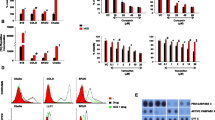Abstract
Cytotoxic activity of drug conjugates of human chorionic gonadotropin (hCG) and doxorubicin alone was investigated compared to doxorubicin in breast cancer cells with and without expression of hCG receptors. Expression of hCG receptor was determined in MCF-7 and MB231 breast cancer cell line using a multiplex nested rt-PCR approach. The entire sequence of mRNA encoding for hCG receptor was detected in MCF-7 but not in MB231 breast cancer cell line. Cytostatic effect of doxorubicin–hCG conjugates was investigated in these cell lines in comparison to unconjugated doxorubicin. The number of viable cells was determined after 24, 48, 72, 96, and 120 h. To exclude non-specific uptake of the carrier hCG from the culture media, a similar experiment was performed with albumin–doxorubicin conjugates. The number of viable cells decreased in a concentration depending manner after doxorubicin and hCG–doxorubicin conjugate treatment. However, the cytotoxic effect of hCG–doxorubicin conjugate was 10-fold increased compared to unconjugated doxorubin in hCG-receptor positive MCF-7 but not in hCG-receptor negative MB231 cells. Albumin–doxorubicin conjugates showed no increased toxicity compared to doxorubicin. We conclude that the cytotoxic effect of hCG–doxorubicin conjugates is mediated specifically via the hCG receptor. By using hCG conjugates, the development of more selective cytostatics can be achieved.
Similar content being viewed by others
References
Chabner B: Cancer Chemotherapy, Principles and Practice. J.B. Lippincott, Philadelphia, 1990
Magrath T: Targeted appoaches to cancer therapy. Int J Cancer 56: 163-166, 1994
Ehrlich P: The relationship existing between chemical constitution, distribution and pharmacological action. In: Himmelweite, Marquard M, Dale H, Elmsford (eds) The Collected Papers of Paul Ehrlich. Vol 1, Pergamon, New York, 1956, pp 596-618
Pastan I, Fitzgerald D: Recombinant toxins for cancer treatment. Science 254: 1173-1177, 1991
Yeh MW, Roffler SR, Yu MH: Doxorubicin: monoclonal antibody conjugate for therapy of human cervical cancer. Int J Cancer 51: 274-282, 1992
Fritzer M, Barabas K, Szüts V, Berczi A, Szekeres T, Faulk WP, Goldenberg H: Cytotoxicity of a transferrin-adriamycin conjugate to anthracycline-resistant cells. Int J Cancer 52: 619-623, 1992
Gabor F, Wollmann K, Theyer G, Haberl I, Hamilton G: In vitro antiproliferative effects of albumin-doxorubizin conjugates against Ewing's sarcoma and peripheral neuroectodermal tumor cells. Anticancer Res 14: 1943-1950, 1994
Zhang W, Lei ZM, Rao CV: Immortalized hippocampal cells contain functional luteinizing hormone/human chorionic gonadotropin receptors. Life Sci 65: 2083-2098, 1999
Tao YX, Heit M, Lei ZM, Rao CV: The urinary bladder of a woman is a novel site of luteinizing hormone-human chorionic gonadotropin receptor gene expression. Am J Obstet Gynecol 179: 1026-1031, 1998
Hu YL, Lei ZM, Huang ZH, Rao CV: Determinants of transcription of the chorionic gonadotropin/luteinizing hormone receptor gene in human breast cells. Breast J 5: 186-193, 1999
Licht P, Wildt L: Gonadal and extragonadal receptors for human chorionic gonadotropin (hCG) and luteinizing hormone (LH). Ass Reprod Rev 8: 152-172, 1998
Emons G, Schally AW: The use of luteinizing hormone releasing hormone agonists and antagonists in gynecological cancer. Hum Reprod 9: 1364-1369, 1994
Schally AV, Comaru-Schally AM: Rational use of agonists and antagonists of luteinizing hormone releasing hormone (LH-RH) in the treatment of hormone sensitive neoplasms and gynecologic conditions. Adv Drug Delivery Rev 28: 157-169, 1997
Page M, Thibeault D, Noel C, Dumas L: Coupling a preactivated daunorubicin derivate to antibody. A new approach. Anticancer Res 10: 353-358, 1990
Licht P, Wildt L: Multiplex nested rT-PCR for sensitive and specific detection of full-length hCG/LH receptor messenger RNA. Hum Reprod 11: 12, 1996
Bernhardt G, Reile H, Birnböck H, Spruß T, Schönenberger H: Standardized kinetic microassay to quantify differential chemosensitivity on the basis of proliferative activity. J Cancer Res Clin Oncol 118: 35-43, 1992
Magrath T: Targeted approaches to cancer therapy. Int J Cancer 56: 163-166, 1994
Affleck K, Embleton MJ: Monoclonal antibody targeting of methotrexate (MTX) against MTX-resistent tumour cell lines. Br J Cancer 65: 838-844, 1992
Belles-Isles M, Page M: In vitro activity of daunomycin-antialphafoetoprotein conjugate on mouse hepatoma cells. Br J Cancer 41: 841-842, 1980
Gruber R, van Haarlem LJM, Warnaar SO, Holz E, Riethmueller G: The human antimouse immunoglobulin response and the anti-idiotypic network have no influence on clinical outcome in patients with minimal residual colorectal cancer treated with monoclonal antibody CO17-1A. Cancer Res 60: 1921-1926, 2000
Mitra S, Gaur U, Ghosh PC, Maitra AN: Tumour targeted delivery of encapsulated dextran-doxorubicin conjugate using chitosan nanoparticles as carrier. J Cont Release 74: 317-323, 2001
Dagar S, Sekosan M, Lee BS, Rubinstein I, Onyuksel H: VIP receptors as molecular targets of breast cancer: implications for targeted imaging and drug deliverya. J Cont Release 74: 129-134, 2001
Konyves I, Muntzing J, Rocencweig: Chemotherapy principles in the treatment of prostatic cancer. Prostate 5: 55-62, 1984
Lojun S, Bao S, Lei ZM, Rao CV: Presence of functional luteinizing hormone/chorionic gonadotropin (hCG) receptors in human breast cell lines: implications supporting the premise that hCG protects women against breast cancer. Biol Reprod 57: 1202-1210, 1997
Srivastava P, Russo J, Russo IH: Chorionic gonadotropin inhibits rat mammary carcinogenesis through activation of programmed cell death. Carcinogenesis 18: 1799-1808, 1997
Russo IJ, Russo J: Hormonal approach to breast cancer prevention. J Cell Biochemistry, 34(suppl): 1-6, 2000
Srivastava P, Russo J, Russo IH: Inhibition of rat mammary tumorigenesis by human chorionic gonadotropin associated with increased expression of inhibin. Mol Carcinogen 26: 10-19, 1999
Jiang X, Russo IH, Russo J: Human chorionic gonadotropin and inhibin induce histone acetylation in human breast epithelial cells. Int J Oncol 20: 77-79, 2002
Author information
Authors and Affiliations
Rights and permissions
About this article
Cite this article
Gebauer, G., Fehm, T., Beck, E.P. et al. Cytotoxic Effect of Conjugates of Doxorubicin and Human Chorionic Gonadotropin (hCG) in Breast Cancer Cells. Breast Cancer Res Treat 77, 125–131 (2003). https://doi.org/10.1023/A:1021301001208
Issue Date:
DOI: https://doi.org/10.1023/A:1021301001208




